RIGHT TURN ONLY!!
Dororororosario!!
by Carlo Santos,

What? A new anime season? But the other one just finished! (Well ... obviously.)
Anyone care to recommend some J-dramas worth checking out this spring?
ANIMAL ACADEMY
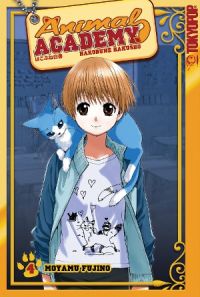
Vol. 4
(by Moyamu Fujino, Tokyopop, $10.99)
FROM THE BACK COVER:
"Everyone's on edge with Yuichi having left Morimori after the devastating revelation that he isn't actually human. Aside from losing one of her best friends (and maybe something more?), Neko is distraight at how the truth about Yuichi affects her own place at this school for animal shape-shifters. But when she herself decides to leave the academy, it's up to Kotaro to bring her back!"
EVIDENCE FOR:
Right up there with "Believe in yourself" and "Never give up" is the old saw about the power of friendship, and sure enough, a school drama like Animal Academy has to hit that point eventually. But a bit of clever presentation and honest emotion is all this series needs to take that message beyond the realm of cliché: while Kotaro is trying to talk Neko into coming back to the academy, they start drawing shapes on the ground, and next thing you know, they've created a chart of every friendship Neko has formed at the school. It is a beautiful, heartwarming sight, a catch-your-breath moment that says all that needs to be said about the decision Neko has to make. But it's a decision that also takes a lot of self-reflection to get to, which is why the early and middle chapters are surprisingly profound, with all of Neko's swirling thoughts about trying to fit in when she knows she doesn't belong. Funny that such a fantastical premise can tackle one of the most realistic aspects of growing up. An uncluttered artistic style and emphasis on laid-back visual presentation also add to the series' uniquely thoughtful mood.
EVIDENCE AGAINST:
For a story that does a great job of teaching valuable life lessons, it sure wades through some convoluted material to get there. Before Neko can even have her crisis of conscience and run off from the academy, there's a whole lot of wrangling and maneuvering between secondary characters whose names and faces are easily forgotten (including, annoyingly enough, two brothers who look exactly alike). And if Moyamu Fujino can't even come up with a distinctive supporting cast for the series, it's pretty much a lost cause trying to remember their motivations, their back stories, and their relation to Neko. Then again, it would appear that plot developments are entirely optional and reversible around here: when Neko decides to run off, she reveals her secret in a way that could change things forever—until she returns to find that a gimmicky plot device has conveniently saved her butt. There are other time-wasters too, like an entire chapter spent in anguish over Yuichi's departure. Neko's crisis and epiphany about her purpose in life could have been a whole lot more—but the wayward storyline dilutes its effectiveness.
FINAL VERDICT:
The storyline sags at times, but when things turn to matters of the heart, that's when this volume excels. That's B- material as our heroine confronts her feelings and her true self.
DOROHEDORO
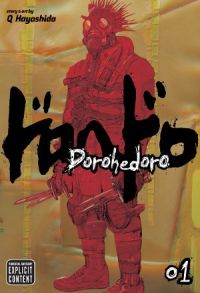
Vol. 1
(by Q Hayashida, Viz Media, $12.99)
FROM THE BACK COVER:
"In a city so dismal it's known only as 'the Hole,' a clan of sorcerers have been plucking people off the streets to use as guinea pigs for atrocious 'experiments' in the black arts. In a dark alley, Nikaido found Caiman, a man with a reptile head and a bad case of amnesia. To undo the spell, they're hunting and killing the Sorcerers in the Hole, hoping that eventually they'll kill the right one. But when En, the head Sorcerer, gets word of a lizard-man slaughtering his people, he sends a crew of 'cleaners' into the Hole, igniting a war between the two worlds."
EVIDENCE FOR:
Time for a bit of the ol' ultra-violence, eh? When it comes to strong first impressions, it's hard to beat Dorohedoro, which opens with a the sight of a lizard-man chomping on some unsuspecting fool's head. Add to that the tearing of skin, the wanton bloodshed, and a living human seemingly trapped inside the reptilian's throat, and we've got ourselves a gore-fest of the highest order. Thanks to Hayashida's obsessive-compulsive penwork and a flair for the grotesque, every page of this volume is a testament to the beauty of ugliness. Even the backgrounds and interiors get into the act, with dirt caked on the floors and walls, buildings on the verge of falling apart, and the bleak atmosphere of an entire society gone to ruin. Yet our scaly hero still finds the willpower to continue on his disturbing quest—probably because he's got a sardonic sense of humor to go with that killer instinct. Even the sorcerers find time to crack a joke or two in between their acts of misanthropy. It's a freak show, all right—and you won't find much better freaks than this.
EVIDENCE AGAINST:
What kind of artist can't even take the time to come up with a more creative place-name than "the Hole"? Let's face it, the world of Dorohedoro may be an alluring concept, but it's hardly what anyone would call an actual story. It's barely even a one-shot. What it is, in this volume, is a collection of scary-pretty pictures, with people attacking each other and killing each other and (maybe) eating each other, but not much else. Ironically, it becomes even more insubstantial during chapters where the story tries to add more substance—bad guys making evil plans, people chatting about the brewing conflict, but no real plot development. In fact, such dialogue just makes things more boring, because now we don't get to see Caiman doing what he does best (chompchompchomp), plus all these side characters only result in more confusion. So while the world-building may be there artistically, the story is deeply deficient: not enough background on the Sorcerers, not enough exposition on how the Hole got to be this way, not even a background on Caiman himself. Because, you know, he lost his memory and all. Which is a lame excuse.
FINAL VERDICT:
Sorry, but there needs to be more appeal than just "crazy lizard-man munching on people's heads." Without a more solid story to back up this concept, it's just C- gore and action so far.
RED HOT CHILI SAMURAI
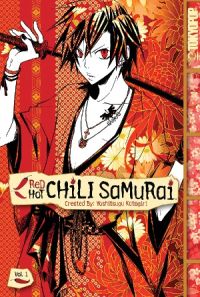
Vol. 1
(by Yoshitsugu Katagiri, Tokyopop, $10.99)
FROM THE BACK COVER:
"Samurai Kokaku Sento likes peppers. Scratch that—he loves them. The only thing Kokaku likes better than eating a hot chili pepper is helping his father kick the butts of bad guys! With the help of his bespectacled friend Ento and cute-pie girl of action Ran, Kokaku will take a bite out of crime—but not before biting a spicy pepper first!"
EVIDENCE FOR:
Well ... it gets better. That's probably the best thing that can be said about this story. Kokaku's adventures get off to a ragged start, but once the series sets a baseline for what his character is all about, it manages to wring out a couple of fun chapters. First there's the one where he meets his rival Shikki, resulting in a clash of egos with plenty of reckless sword-swinging and verbal jabs at each other. The other highlight is when Kokaku's prized pepper field gets bought out by a land developer, causing our hero to go on an epic rampage. The sheer level of action and humor in this chapter proves that warriors are at their best when they're fighting for what they really believe in. And indeed, the fights are always the best part of each chapter—flashy sword moves, effects and speedlines everywhere, and the satisfaction of seeing the bad guys get exactly what they deserve. That's just the samurai way.
EVIDENCE AGAINST:
When the author's notes say things like "Well, I wanted to make up a character who was always eating something" ... it can only get worse. Characters created for the sake of creating characters belong on DeviantArt or Pixiv, not in a multi-chapter manga series—and yet here we are, with a protagonist whose conception is as flimsy as the stories he's thrown into. The opening chapters are an absolute mess, introducing Kokaku and his friends far too quickly and without any explanation, and then sending them off on missions without any background on how they landed this gig in the first place. It's as if Yoshitsugu Katagiri knew the whole series in his head, but forgot to include any of the important parts like introductions, character background and development, world-building ... you know, any of the things that would actually allow one to "get into the story." Instead we are constantly left outside the story, with cheap one-dimensional characters all over the place, storylines copied from other action-adventure titles but far sloppier in execution, and visually overloaded fight scenes where it's hard to spot who the good guys and bad guys are. In other words—total failure.
FINAL VERDICT:
Even a couple of decent chapters can't save the incredible lameness of this series, which relies mostly on the pepper-eating gimmick and therefore has nothing else to back it up. It's lucky to escape with a D.
ROSARIO+VAMPIRE: SEASON II
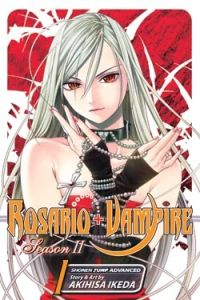
Vol. 1
(by Akihisa Ikeda, Viz Media, $9.99)
FROM THE BACK COVER:
"Average human teenage boy Tsukune accidentally enrolls at a boarding school for monsters—no, not jocks and popular kids, but bona fide werewolves, witches, and unnameables out of his wildest nightmares! And now he's a sophomore!
On the plus side, all the girls have a monster crush on him. On the negative side, all the boys are so jealous they want to kill him! And so do the girls he spurns because he only has eyes for one of them—the far-from-average vampire Moka.
On the plus side, Moka only has glowing red eyes for Tsukune. On the O-negative side, she also has a burning, unquenchable thirst for his blood..."
EVIDENCE FOR:
The girls are pretty, the monsters are menacing, and the action is intense. Yes, it's the same Rosario+Vampire you've always loved, only with a "Season II" suffix and rebooted for the new school year. Naturally, this also means bringing in a new character—and what could be a better choice than Moka's little sister, Koko? This twintailed Energizer bunny goes around threatening violence on everyone, challenging Moka to battle, complaining that Moka and her friends have gone soft, and generally being a hilarious pain in the Asmodeus. For true entertainment value, though, it's still Moka who takes the crown, either making an embarrassment out of Tsukune or punching and high-kicking her way through various monsters. As always, the creatures in this series are a frightening wonder to behold—in this volume we get a minotaur and a tentacular plant—and the magical firepower possessed by Tsukune's harem is just as visually impressive. Even the variety of character designs is above-average—no one's ever going to mistake one of the girls for any of the others. So this sequel's got the eye candy covered, it's got the horror-action covered, plus a healthy dose of humor. What could possibly go wrong?
EVIDENCE AGAINST:
Actually, plenty goes wrong in this volume. Like not having enough of an engaging, high-stakes storyline, presumably because it's a "Volume 1" and therefore we have to completely start over by re-introducing all the characters (boooooring) and going on stand-alone adventures against weak, low-level monsters that will never be seen again. It's bad enough that the entire introductory chapter is basically wasted on the girls bickering over Tsukune, but for the Koko chapter to repeat the same thing with one extra character is unforgivable. This might as well be labeled Rosario+Vampire: Season 1.5 for all the plot advancement it gets. By the time things do start to get interesting, it's already the last several pages in the book, plus Moka hasn't even had a chance to unleash her powers as much as she usually does. If this is supposed to hook in new readers, it's doubtful that they would find it engaging—the best part about the series is hot girls beating up monsters, and instead we get blasé harem antics. Meanwhile, existing readers will be bored out of their minds, because they know what the series is capable of in terms of excitement—and it certainly isn't this.
FINAL VERDICT:
Well, for a series with vampires in it, you could do a lot worse (see below). But you could also do a lot better. This fun-but-feeble effort lands right on the C mark.
XXXHOLIC
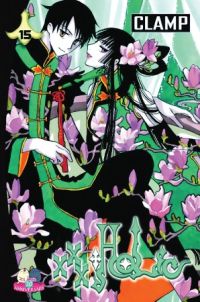
Vol. 15
(by CLAMP, Del Rey, $10.99)
FROM THE BACK COVER:
"Kimihiro is having some wish-granting success with his very first customer, but his efforts are interrupted by a disturbing dream of the witch Yûko vanishing forever. Even people Yûko has helped are saying they've never heard of her. Too bad there is no such thing as 'just a dream' in Kimihiro's universe..."
EVIDENCE FOR:
Has the student become the master? Of all the character developments in xxxHOLiC, none has been quite as remarkable as seeing Watanuki teaching Yûko's Zen ways to a naïve, unwitting customer. His eloquent thoughts on the metaphysics of cooking—how handmade cuisine is a reflection of one's self—are worthy of anything the grand old lady has ever said. Speaking of which, Yûko is frequently MIA in this volume, but her absence emerges as one of the strongest plot points in this haunting story arc—and when she does appear, it is to provide an incredible, tearful climax that perhaps nobody ever saw coming when the first chapter of the series was published. In between these vital revelations, however, there's still time for laughs: Watanuki mouths off at old rival Dômeki as always, because you can't have great drama without some good humor to balance it out. Whichever way the mood turns, the artwork remains consistently beautiful, from the piercing simplicity of Watanuki's cooking lessons to the otherworldly aura of Yûko's appearances. This series' artful use of pure black and white, along with traditional motifs and sinuous lines, are always striking to the eye—not to mention a brief, dramatic appearance by some familiar dimension-hopping adventurers.
EVIDENCE AGAINST:
As xxxHOLiC turns inward to explore the souls of its central characters, something has sadly been lost. Whatever happened to those delightful encounters with the birds and beasts of Japanese folklore, or the dazzling acts of magic that could only come from CLAMP's combined imaginations? Too many pages of this volume are nothing more than Watanuki and friends standing in a plain room, or on a street corner, discussing mystical happenings but never actually participating in any mystical happenings. The worst part is when we get to Yûko's heartbreaking revelation, which happens against a background of full black—sure, it fits the theme of the series, but that's also a cheap, gimmicky way to pump out a lot of pages quickly. Meanwhile, the storyline still has a tendency to get mired in its own philosophical mumbo-jumbo, with Watanuki trailing off into cooking-related monologues, and Yûko sounding like a spiritual self-help manual when she natters on about time stopping and restarting and everything else going on in Tsubasa-land. Come on folks, get back to the action.
FINAL VERDICT:
The shortage of artistic "wow" moments is easily compensated by the dramatic turns of story in this volume, which earns a worthy B+.

TWILIGHT
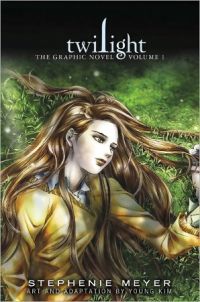
Vol. 1
(by Stephenie Meyer and Young Kim, Yen Press, $19.99)
FROM THE BACK COVER:
"When Isabella Swan moves to the gloomy town of Forks and meets the mysterious, alluring Edward Cullen, her life takes a thrilling and terrifying turn. With his porcelain skin, golden eyes, mesmerizing voice, and supernatural gifts, Edward is both irresistible and impenetrable. Up until now, he has managed to keep his true identity hidden, but Bella is determined to uncover his secret..."
EVIDENCE FOR:
Fans of the English language will agree: the best thing about the Twilight comic is the dilution of Stephenie Meyer's stultifying prose. Well, not all of it—Bella still narrates frequently—but the beauty of Young Kim's art does a better job of showing than Meyer's words ever did with telling. The wet winters of the Pacific Northwest are captured perfectly in dense shades of gray, not to mention the natural landscape scenes that seem pulled straight out of National Geographic. The character designs are also stunning in their richness of detail—none of that horrendous "D.J. Milky got me my first paying artist job!" style here—with Edward's unearthly Korean-boy-band good looks being the main draw, of course. (Let us also be infinitely thankful that Kim resisted the urge to base the character designs on the movie cast.) A handful of color pages even find their way into the book, bringing the famous "sparkle" scene to vivid life the way only an artist's hand can. Then there is the haunting beauty of Bella and Edward's relationship itself—a mystical push-pull force that gives the story its unmistakable aura.
EVIDENCE AGAINST:
Welcome, avid readers, to the Super-Popular Vampire Story Where Nothing Really Happens! Never has there been a blander example of falling in love—these characters literally just mill around and chat for a couple of hundred pages until they suddenly decide that they want to be together FOREVER. There is no dramatic conflict that kindles their love for each other, no triggering incident that sets their feelings aflame (the car crash doesn't count; that was only to get Bella to notice Edward's abilities in the first place). The development of this paper-thin relationship goes something like this: "Hey, you're really hot!" "And so are you!" "But we're too different." "Then let's be ill-fated lovers!" Seriously, what? And while that staged conversation was a joke, the entire book is littered with brainless ping-pong dialogue just like that—exchanges intended to sound witty or charming, but probably wouldn't even pass muster in a first-year screenwriting class. Bella's inner monologue and narration is just as bad, with all the elliptical sentences and emotive goop so reminiscent of grade-school shoujo manga. Except this is originally in English. Alas, it looks there is no escaping Stephenie Meyer's bad writing after all.
FINAL VERDICT:
Like many other works involving pretty boys and the supernatural, this is a work of eye-catching beauty—but it is empty, mindless beauty, with a non-story story that will leave readers wondering why they should care about the characters in the first place.
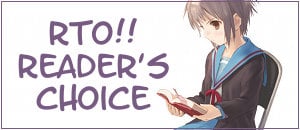
And the negative reviews have come rolling in! I'd like to thank everyone who submitted—this is the stuff that, in my opinion, often brings out the true passion of fans. Like, let's say, you're really into Kaori Yuki. Gotta love all that dark, gothic stuff. Right? Wrong! As Ingrid B. tells us in this review, even the queen of darkness has her off-days:
FAIRY CUBE
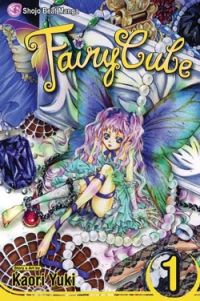
(by Kaori Yuki, Viz Media, $9.99 ea.)
Every author has one work that doesn't meet his or her standard of writing. Robert Jordan, author of the best-selling fantasy series The Wheel of Time, had the dreadful historical novel The Fallon Blood. Alice in Wonderland's Lewis Carroll had the bland Sylvie and Bruno. And Kaori Yuki has Fairy Cube, a gothic manga about a young boy whose body is stolen from him by a mysterious stalker spirit and tries to regain it while stopping some wicked fairies from taking back the earth. While on paper this sounds like an epic adventure, Fairy Cube quickly dissolves into an oozing gothic mess of missing or dead mothers, abusive fathers, cross-dressing, back-stories, twins, men with eye patches, and heaps of abuse and fairy wings.
The lack of character development cripples this manga. The cheerful Ian, a departure from Yuki's gloomy and tortured protagonists, never changes and never presents the reader with a reason to care about him: he evokes no empathy or a need to see the end of his quest. Even worse is his secret love, Rin. While it is nice to see Yuki have a female lead who is in love with the protagonist and not related to him for a change, as opposed to all the incest in Angel Sanctuary and to a lesser extent Godchild, Rin spends all of Fairy Cube's short lifespan being clingy, without personality, and failing to win over the reader. This is extremely disappointing characterization from Yuki, who usually creates the most tortured and oddly sympathetic characters.
Additionally, the very length of the manga prevents it from reaching any of the horrid beauty of Yuki's longer mangas. At only three volumes, it condenses events which should have affected the reader and characters simply to become a carousel of meaningless events and back-story. Possibly the only thing to redeem Fairy Cube is Yuki's beautiful, detailed art. But even that becomes messy in a few sections.
In short, Fairy Cube does not live up to Yuki's previous works, in characterization, art, and plot. However, she was a new mother caring for a young son when she wrote Fairy Cube so hopefully her next manga will be much better. Not that it'd take much effort.
Is there a hidden gem of manga you'd like to reveal to the world? Is there a piece of garbage that deserves to be bashed in public? Or is there a title that didn't get a fair grade here, and you want to set the record straight?
Now's YOUR chance to be the reviewer! Write a review of about 300-400 words (a little more or less is fine) and include:
- Your name
- Title of manga (and volume no., if applicable)
- Author/Artist
- Publisher
- Briefly describe the story, then explain why this manga is great, terrible, or in between. Be objective, but also be entertaining.
Then send it in to rtoreaders (at) gmail (dot) com (plain text format preferred). One review will be selected out of all the submissions and will be published in the next column. All types of manga and manga-inspired comickry are accepted, from past and present, from Japan and beyond—what matters is that it's the Reader's Choice! NOTE: Submissions may be edited for formatting and grammar.
discuss this in the forum (20 posts) |